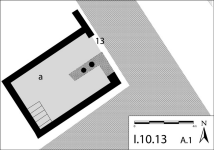
Figure 15: Bar at I.10.13, Pompeii.

Figure 15: Bar at I.10.13, Pompeii.
Fourteen Type A bars consisted of a single room only, accounting for 11% of all Type A properties. The average ground floor area was 26m², as exemplified at I.10.13 (Figure 15). The smallest example was at IX.1.13 with 15m², while both VII.2.32-33 and VII.11.7-8 were 35m². Access to an upper storey or mezzanine level is known for every example, though at VII.6.22-25 (counter at entrance 24) the access was gained from the neighbouring shop at entrance 25. Likewise, the bar at III.11.5 could access two neighbouring retail outlets at entrances 4 and 6. Such groups of retail outlets are likely to have come under single ownership. Other Type A.1 properties were spatially separated from neighbouring and attached properties by the blocking of doorways. The blocking of the doorway from I.10.13 to the neighbouring stable at entrance 14 was incomplete at the time of the 79 AD destruction (Ling 1983, 52). Four examples exist of small, single-room bars that were once attached to atrium style houses (VI.2.5; VII.6.1-2; VIII.2.35; IX.1.13). The separation of activities between the house and bar in these last examples is evidenced by the blocked doorway at IX.1.13. It is unlikely that the social and economic relationships between these types of bars and the houses to which they were once attached ceased, but the physical connection certainly did.
© Internet Archaeology/Author(s)
URL: http://intarch.ac.uk/journal/issue24/4/6.1.1.html
Last updated: Mon Jun 30 2008